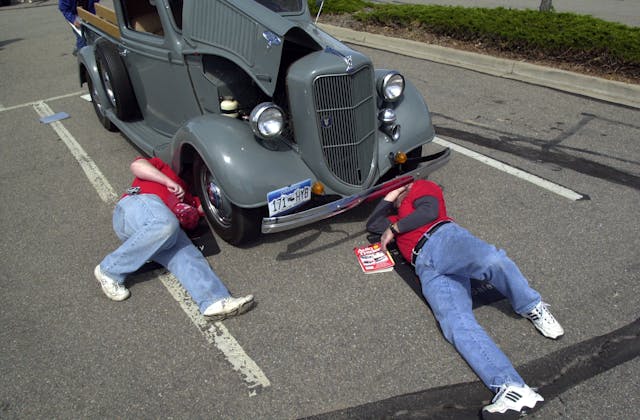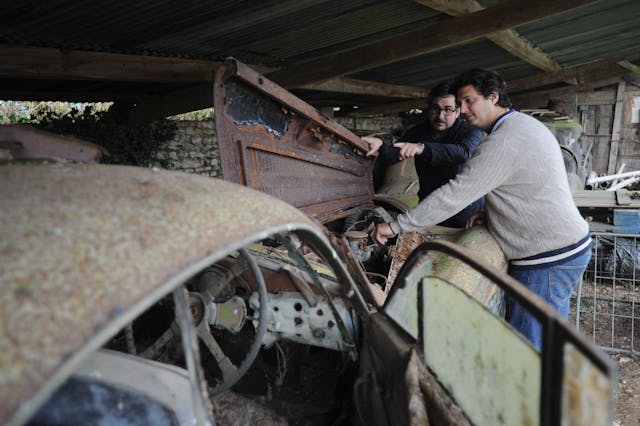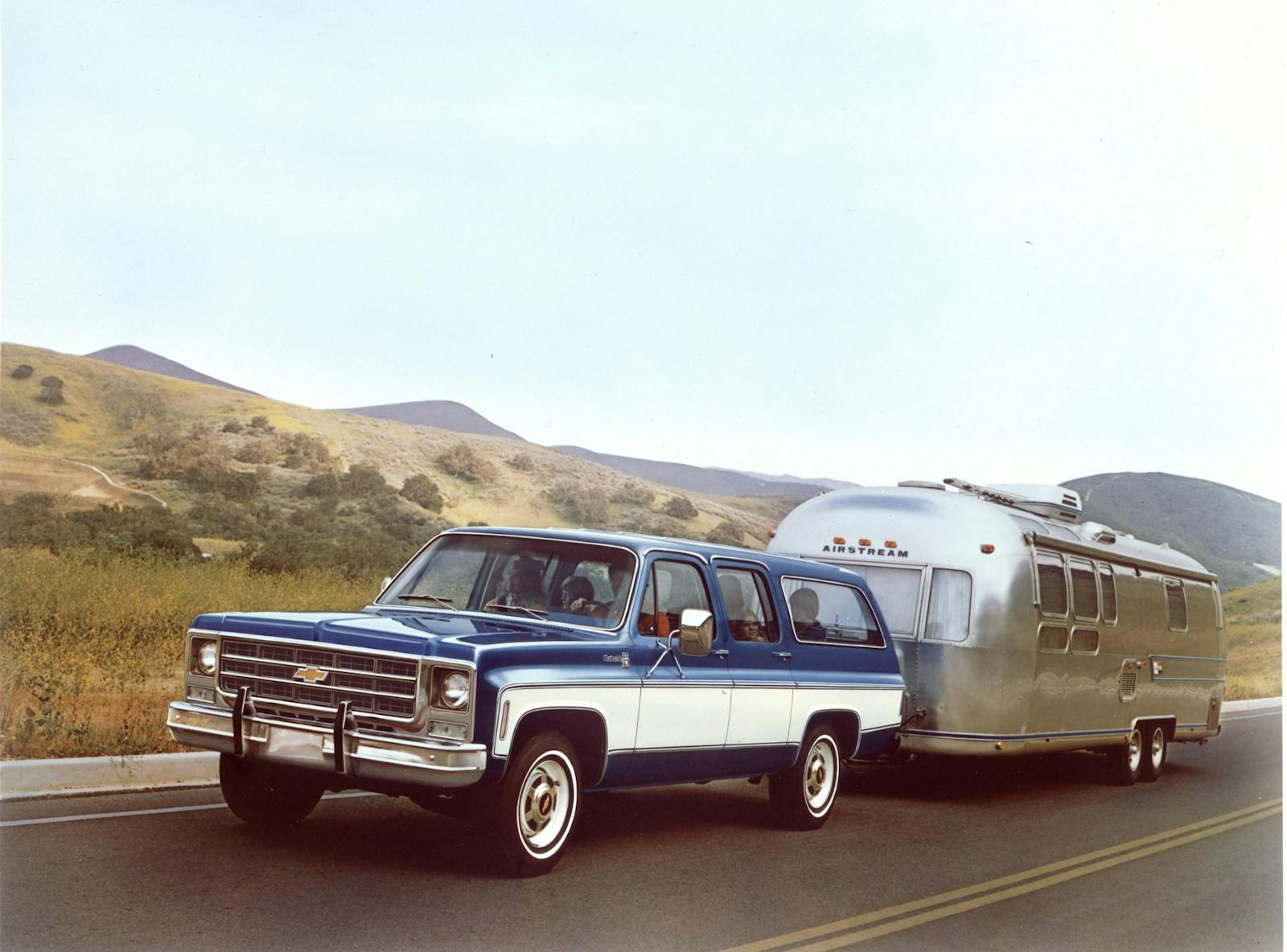Do you really need to see a car before you buy it?

In addition to benefitting from a trove of data, Hagerty Insider also relies heavily on the expertise of veteran market watchers, including Dave Kinney, appraiser and publisher of Hagerty Price Guide. Though Dave can’t use this space to put a value on an individual car (that’s what people pay him to do in his appraisal business, after all), he can field questions about the appraisal process, how to go about buying and selling classics, and the industry as a whole. Have a question of your own for a future article? Ask in the comments section.
I was looking at ads online and I got in contact with a seller. After a long series of questions and answers, he insisted that I come and look at, and drive the car myself or send a representative. Is this a boomer thing, or is he trying to head off what he thinks might be a scam on my part? — Anonymous
DK: I have no idea what his motives are, but I congratulate him on his resolve for finding a correct new owner for his car. I’m sorry, but he has a point. I think what he is trying to head off is not a scam but your possible disappointment. There is nothing like taking a look, and a drive, and a walkaround before buying a new-to-you car. And there is a twist to this tale: the cheaper the car, the more important this might be.
Hear me out on this. If you are buying a $300,000 car and the interior is moldy, a thorough cleaning with seat removal and hand cleaning of all soft-touch surfaces might take three hours for removal and replacement of the seats, and eight hours for a thorough cleaning. For sake of argument, let’s call it a $1500 job. The cost on a $30,000 car? About the same. As a percentage of the value of the car, it’s a big difference. Can you do this job yourself? Probably. Do you want to or have time to? That’s a question only you can answer.

I don’t do what are known as pre-purchase Inspections (PPIs) and I haven’t for over fifteen years. Why? Simple. Without knowing the customer, I can’t possibly know their likes and dislikes, expectations, personal tastes, or which way they might fall on a judgment call. Is he 6-foot-6 and won’t fit into that 1956 Thunderbird he so wants? Is she not used to the feel of non-power brakes? Do they realize that a slight oil leak on a 50-year-old, $14,000 British car is acceptable to most?
No one can know your complete and total list of likes and dislikes except you. There are thousands of components to every automobile. Are you okay with slightly pitted chrome around the dials of the gauges, but would consider the same amount of pitting surrounding the vent windows to be a deal breaker?
If you were thinking of purchasing a 1965 Mustang (or ’66 Corvette, or ’67 Ferrari GTC) and it is to be your first collector car, unless you have a friend who has one, you might be in for a tremendous shock. Cars from fifty and sixty years ago are different. On the plus side, they are generally easier to fix, are more straightforward in their level of complications, and, I would argue, more fun to own and drive. A well-maintained (or well-restored) car from “back in the day” can be a time machine, a new hobby, a family treasure, and a point of pride.

One thing a fifty-year-old car can’t do is drive like today’s cars. (This helps explain the restomod movement—cars for people who want the old-school look with many of the comfort and power features found on newer cars). Only you can determine whether this particular car will light your fire.
With that in mind, who should go look at a prospective purchase? The answer is you, or a trusted friend who knows cars of the era, or ideally both. Can you send a mechanic? Sure, but what about the cosmetics? I could go on, but it’s your money and your decision. This is a judgment call. Talk to members of the car club associated with your desired model, learn the ups and downs of the car you are thinking of buying. Explore, shop, and buy wisely, and you’ll know you got exactly what you were looking for.
***
Check out the Hagerty Media homepage so you don’t miss a single story, or better yet, bookmark it. To get our best stories delivered right to your inbox, subscribe to our newsletters.


I will do all I can to see and look over a car before I will buy one. In a case of need I have a select few people that I would send to look at a car to see if it is worth he effort to go look at it.
For me to travel I would ask for a number of photos of a car in key areas to see the condition. I generally will know a car well before I buy and would know what to look for to see if it is worth the trip.
Case in point my last purchase of a Corvette C5. The condition of the drivers seat is like staring right into the soul of the car. If the seats have been conditioned and cared for the rest of the car tends to follow. If the drivers seat is cracked and in poor shape odds are the rest of the car was not cared for as well.
Other cars photos of where frames rust or where they leak are telling on the carte to decide if it is worth the drive or air ticket.
I also try to bring others I trust with me as extra eyes with no new car emotion can be helpful.
As for auctions cars I find they are either very top end or someone trying to dump a car. It is a real mix. Too often you never will know what all you are buying as you seldom have one that is documented well. Now once in a while a seller will document but not often enough.
I find it kind of hilarious how the question was: is this a “boomer” thing? What? Asking a person to look at and drive a machine that will cost several thousand (or more)? looking it over because if it doesn’t drive well (steering, brakes, etc.) it could actually kill you?
Are the younger generation afraid to meet and talk in person? What is their damage? They are so used to connecting through their phones that meeting a person is actually strange to them. Mind boggling.
*And I’m not a “boomer”, I’m GenX, the generation that basically had to raise themselves.
I am a boomer and that question perplexed me. I suppose it has a modicum of truth to it – we were certainly raised in an era where we “kicked the tires” of almost anything we purchased, let alone something as significant as a car. And you have a good point, MeJ, in that boomers grew up in a much more “outgoing and engaging” time than we see these days. I’m still guilty of saying “Good Morning”, “How Are You?”, “Please”, and “Thank You” to complete strangers as I go about doddering around in public. It bewilders many younger folks, that’s for sure!
Never cease your above politeness, DUB6. As with appreciating authentic pre-1950 cars over SBC 350/Turbo HydraMatic “retro rod” Frankencars, some of us have to serve as keeper of the flame for civil discourse.
Been trying to figure this out as well. There are plenty of people buying jdm cars from sellers on Instagram. Sight unseen, no test drive and trusting the entire import process. I’m not old enough to be a boomer but that’s crazy to me unless it’s a week known us company and even then….
Oh heck, people are even buying million-dollar HOMES just from internet pictures, not just cars. A guy close to our place bought his for BIG bucks, then moved his family here before any of them had seen anything but online photos (or possibly a video). Then they spent even MORE big bucks doing landscaping, repairs, and remodeling to the place – crazy (IMO). 🤪
At least in my case (as an early millennial), I knew it would be a PITA for me to get to ON from SC just to scope out one car, so I paid an inspector $400 to do it. My main driver wasn’t the cost of the ticket, but trying to even get a day off work is like pulling teeth. I imagine self-employed or retired people don’t have to deal with “time poverty”.
I have purchased 3 cars sight unseen and have been thrilled with all of them. I talk for hours with the seller, to get a feel for their honesty. I agree with the person that said, if the interior is in great shape, generally the rest follows. On my first one, which was a 77 Trans Am SE, I also had a very knowledgeable person, who restores cars for a living, call and speak with the person. I purchased a 73 Super Beetle off of Ebay. He happened to be a dealer in TN. The car was immaculate!! I purchased a 2012 Mini Cooper S Roadster from a dealer on the other side of the country from me. The car is gorgeous!! I was also able to get an Endurance warranty on it because of the cost of possible repairs. Anything done on a Mini is expensive!
So it can be done if you know how. Are the cars perfect? No. What car is?? These are pretty close.
Buying a car sight unseen? For every positive experience out there – there’s probably ten negative ones. Even if the seller is completely honest, and posts 100 photos plus a walk around video – there are so many unknowns. What if the seller is NOT a car person and doesn’t think about smoke at startup or oil leaks?
Mom-in-law needed a replacement car after someone totalled hers, bought a 38000 mile Camry from a dealer with the full Toyota Certified Pre Owned. I happened to go to drive her somewhere in it and wondered, “Why’s it smoking?” Her mechanic looked for a bit and said, “You need to go back to Toyota!” Turned out to be filled with sludge, speculation was that it hadn’t had its oil changed in maybe ever. New engine for her, on their dime. I’m betting that more than one of their 57 point CPO inspections had been, uh, passed over, and that probably someone got chewed out or canned for that one! So, competent pre-purchase inspections seem like a good idea.
The point of this story is more about Web buys that can be miles away. It used to be only aA Hemings sales was out of town but now you can find a car anyplace for sale that you may not easily travel to see.
Some clubs will send members to look for you but you are still taking a risk as what is good for you may be crap for me.
As for those who have not had a bad experience it is a matter of time. Web photos are never as accurate as being in person. Also talk is cheap. I have had guys that act like a best friend but fail to disclose much.
As Dr House states Everyone Lies. At least in selling cars. It may not be everyone but many do.
Sadly many can’t buy a car in person let alone over the web without making mistakes.
In most cases I would have to agree with the touchy feelie part of the buying process. To a lot people, many thousands of dollars is nothing to be concerned with and if it doesn’t turn out fantastically…oh well. I may very well be the minority here in that I don’t have a bank account with seven zeros in it (unless you go right of the decimal) so I tend to want to see things first before laying out hard-earned cash.
I did learn something interesting from the article though. I’ve never seen a 50yr old British sports car that isn’t gushing oil. I was unaware these are called ‘slight’ leaks. Not even lunchtime and I’ve already learned my one new thing for the day.
Heh, at the old college autocross events the course workers were cautioned to look for any fluids coming from the cars on course. Then the Safety guy would add, “Or in the case of British cars, unusual amounts of fluids.” And the MG /Triumph guys would hang their heads and intone, “Yeah, we know!” Never failed to get a chuckle.
Good article, and many good points from readers. If you care nothing about quality and details, and perform repairs using an overflowing checkbook, then MAYBE buy without an inspection and/or ride/drive. I’ve bought exactly 1 collector or used car without inspecting it & driving it beforehand, and that won’t happen again.
I’ve purchased a number of cars off E-Bay and only had one bad experience when the seller lied about everything.
I’ve seen cars advertised and presented by the seller as “rust free”, only to find out when I drive hundreds of miles to close a deal, that they really meant that the rust was for free. I would never buy a car without seeing it, unless it is a new(er) car from a dealer that still has a factory warranty on it.
Generally, I try to go look at a car in person that I’m interested in, but sometimes that’s not possible or practicable. Of course, the more money potentially at stake, to more motivated I am going to be to go see a car, even if it’s a great distance from where I live. Of course, that monetary threshold might vary from person to person.
I’ve purchased maybe 3 or 4 cars over the years sight unseen, and all turned out okay, with expectations more or less met, and no nasty surprises. In every case, though, I’ve either paid for a PPI by a reputable shop in the area where the car was for sale, or tried to contact a known expert or marque club member in that area to see if he or she knows about the car and/or might be willing to go an check out the car for me.
One car I purchased sight unseen was a ’65 Shelby GT350, which I purchased in 1988 while on active duty in the US Navy. I was stationed in Virginia Beach, VA, the subject car was in St Paul, MN, and given my duty schedule there was no way I was going to be able to go see the car. Realize, too, this was when these cars were still affordable to mere mortals, so the money at stake, while quite a bit for me personally at the time, wasn’t anywhere close a “mortgage-level” risk proposition.
Anyway, I contacted the WI-based SAAC regional rep at the time to see if he knew of the car, and indeed he knew both the car and the owner very well. Based on his recommendation — it was an unrestored but excellent “survivor” with in-period SCCA racing history, and basically he said “if you don’t buy it I will!” — I went ahead and bought it. Everything turned out exactly as described and I owned and enjoyed that GT350 for the next 12 years!
On the other hand, I bought a 2000 Ferrari 550 Maranello jointly with a friend back in 2017. We looked into 6 or 7 examples from afar, but there were three 550s that were for sale in the Atlanta area at the time, and given the value of these cars, I decided I needed to see & drive each one person. So, I took a direct flight down to ATL early one Friday to go check out all three. I’m glad I did, given all that can be wrong with these cars, and we ended up buying one of them, a really nice, sorted example.
So, yes, I’d recommend “see & drive” before you buy, but there are good ways of verifying a car’s condition if that’s not possible. It just might take a little extra leg work.
I normally buy new cars that will be daily drivers. In the early ’70s, I had a ’69 Super Bee six-pack, that I loved. It was my daily driver. I was in the Air Force and assigned to an area that I could not take my Bee, so I sold it. In the early 2000s, I got the bug for another Super Bee. I bought one, sight unseen except for pictures, from a shop half way across the country (440, 4bbl, auto). That was 2004. Then the project started to turn that car into the muscle driver that I envisioned. I still have that car in 2023, and it is now the Bee(Tribute) that I planned, due to added modifications spread over all these years. Just lucky, but the buy, sight unseen, was righteous.
A boomer thing, no it’s common sense. A coworkers son just yesterday drove a good distance to view a VW Gti and it was not as advertised, it was in bad shape. Shame on that seller.
When I sold my 2002 Trooper I encouraged anyone inquiring to come view it and drive it, even though my ad described every flaw I knew of and it was a smokin good deal. I dunno… not a boomer or any other generation thing, just the smart way to buy/ sell a car.
Buying a car without seeing it can bite you. I was not thinking when I bought a truck online. When I got it home there was a lot of disappointment but also a few good things. I will never buy another with seeing it in person.
I have purchased four cars recently to add to my collection. The first was being sold by a dealer about 150 miles away. I asked him to describe any known defects, which he did. I went to purchase the car and found he was very honest in his description and the price was fair, so I purchased the car and drove it home.
The second was a private seller about 1,000 miles away. The seller sent pictures and what he knew of the history of the car. It was low mileage for its age and had only one owner previous to the seller. We agreed to a price in November and he agreed to store it in his heated garage over the winter until I could pick it up in the spring. The price was slightly higher than I felt fair but when I saw the car it was worth it.
The third car was about 2,000 miles away. I called a marque parts retailer in the area and asked if he knew someone who could inspect the car for me. He recommended a person who made a living doing roving mechanical work on these cars in the area. This person inspected the car and made a list of items he found that needed correction. He also stated that he felt I would be hard pressed to find another example of this car in this condition. It was a CA car with no appreciable rust, which was one of my criteria. I reached an agreed price with the owner and the sale was made. Prior to shipping the car to me, I had the person who did the inspection correct some of the items on the list of issues.
After receiving the car, I found many items that were not caught in the inspection and other items that were pleasant surprises. The primary item that was less pleasant was that the car has a unibody and had evidently been high centered at some time and the floor had been pushed up in the rear seat foot area about an inch. This has been partially corrected with some additional work yet to be done.
The last car was purchased from a dealer that I had known for awhile and trusted. He was about 500 miles away. I visited at one point, drove the car, and noted some of the issues. He offered a very favorable price and delivered the car on a trailer when the timing was right. The favorable price provides some room to correct the various issues to make the car as nice as desired.
As noted above, I have had a mixed bag of experiences but generally will not buy without an inspection by myself or a competent person. I will not buy at auction because the cars cannot be driven.
The owner of the body shop that does my work stated to me that he cannot restore a car for auction and do a totally proper job as there is then no profit in the sale. He stated that to sell at auction he has to take short cuts to keep the cost of the restoration within a margin that allows a profit on the sale.
I have purchased a few without touching first. One from the Houston area (pre last major hurricane / flood), I was lucky to have a cousin who could go do a walk around and drive it, perfect vehicle. The dealer even put in a new OEM windshield because of a chip they discovered. Another, from Texas, was described as perfect by the broker, original owner passed away, only driven on Sundays, etc. Turns out the one owner was a chain smoker, burn holes in the seats, headliner, door cards, and the smoke smell could never be eliminated. Make the right deal, hopefully enjoy it, and if the vehicle is wrong, send it down the road.